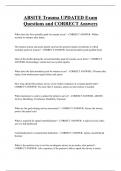ABSITE Trauma UPDATED Exam
Questions and CORRECT Answers
When does the first mortality peak for trauma occur? - CORRECT ANSWER- Within
seconds to minutes after injury
The trauma system and acute patient care has the greatest impact on patients in which
mortality peak for trauma? - CORRECT ANSWER- Second mortality peak (golden hour)
Most of the deaths during the second mortality peak for trauma occur from? - CORRECT
ANSWER- Hemorrhage, central nervous system injuries
When does the third mortality peak for trauma occur? - CORRECT ANSWER- 24 hours after
injury, from multisystem organ failure and sepsis
How long should the primary survey in the initial evaluation of a trauma patient take? -
CORRECT ANSWER- No more than 5 minutes, unless an intervention is needed.
What mnemonic is used to conduct the primary survey? - CORRECT ANSWER- ABCDE:
Airway, Breathing, Circulation, Disability, Exposure
What are the goals during airway assessment? - CORRECT ANSWER- Secure the airway,
protect the spinal cord
What is required for spinal immobilization? - CORRECT ANSWER- A rigid cervical collar,
use of a full backboard
Contraindications to nasotracheal intubation: - CORRECT ANSWER- Apnea, maxillofacial
fracture
What is the quickest way to test for an adequate airway in an awake, alert patient? -
CORRECT ANSWER- Ask a question, if the patient is able to speak the airway is intact.
,Indications for a surgical airway: - CORRECT ANSWER- Anatomic distortion as a result of
neck injury, massive maxillofacial trauma, inability to visualize the vocal cords (blood,
secretions, airway edema)
What are the goals during the breathing assessment? - CORRECT ANSWER- Secure
oxygenation and ventilation; treat life-threatening thoracic injuries
What should be done on physical examination to adequately assess breathing? - CORRECT
ANSWER- Inspection (air movement, cyanosis, tracheal shift, JVD, respiratory rate,
asymmetric chest expansion, open chest wounds, use of accessory muscles of respiration)
Auscultation/percussion (hyperresonance or dullness over lung fields)
Palpation (flail segments, subcutaneous emphysema)
What life-threatening conditions must be treated during the breathing assessment if
encountered? - CORRECT ANSWER- Open pneumothorax, tension pneumothorax, massive
hemothorax
What is the most common cause for upper airway obstruction? - CORRECT ANSWER- The
tongue
What is the preferred emergency airway procedure? - CORRECT ANSWER-
Cricothyroidotomy
In a patient with poor peripheral upper extremity access, what alternative routes can be
considered for intravenous access? - CORRECT ANSWER- Femoral vein at the groin,
venous cutdown on greater saphenous vein at the ankle, subclavian vein, IJ
What are the goals of the circulation assessment? - CORRECT ANSWER- Treatment of
bleeding, assuring adequate tissue perfusion
What is the initial test for adequate circulation? - CORRECT ANSWER- Palpation of pulses
What systolic blood pressure are you expecting with a palpable radial pulse? - CORRECT
ANSWER- 80 mm Hg
,What systolic blood pressure are you expecting with a palpable femoral/carotid pulse? -
CORRECT ANSWER- At least 60 mm Hg
What should be done of physical examination to adequately assess circulation? - CORRECT
ANSWER- Obtain heart rate and blood pressure; check peripheral perfusion and capillary
refill, mental status; examine the skin
Which patients may not demonstrate tachycardia with hypovolemic shock? - CORRECT
ANSWER- Patients on beta-blockers, well-conditioned athletes, patients with concomitant
spinal cord injury
During femoral catheter placement, what is the pneumonic used to remember the anatomy of
the groin? - CORRECT ANSWER- NAVEL (from lateral to medial): Nerve, Artery, Vein,
Extralymphatic space, Lymphatics
What is the preferred alternative route if intravenous access cannot be obtained on a small
child? - CORRECT ANSWER- Intraosseous tibial plateau
What are the goals of the disability assessment? - CORRECT ANSWER- Determination of
neurologic injury
What should be performed during the physical examination for an adequate assessment of
disability? - CORRECT ANSWER- Mental status (GCS), pupils for size, appearance, and
reactivity, motor/sensory examination for lateralizing extremity movement and sensory
deficits
What are the goals during the exposure portion of the primary survey? - CORRECT
ANSWER- Completely disrobe patient and thoroughly inspect and evaluate the patient; keep
patient in warm environment.
What 3 elements are measured with the GCS? - CORRECT ANSWER- Eye opening, best
verbal response, best motor response
What does a GCS score with a T signify? - CORRECT ANSWER- Patient is intubated
What is the highest GCS an intubated patient can have? - CORRECT ANSWER- GCS 11t
, What is the secondary survey? - CORRECT ANSWER- A complete physical examination,
obtain labs and x-rays, place additional lines, tube (foley, ngt), and monitoring devices
When should the tertiary examination be performed? - CORRECT ANSWER- Another
complete head-to-toe physical examination should be performed 12 to 24 hours after the
initial trauma and should be aimed at identifying injuries missed during the primary and
secondary surveys.
What are the typical signs of a basilar skull fracture? - CORRECT ANSWER- Raccoon eyes,
Battle sign, clear otorrhea or rhinorrhea, hemotympanum
What is the "halo" sign? - CORRECT ANSWER- A halo of clear fluid around drainage from
nose and ears, representing basilar skull fracture with CSF leakage.
What conditions must be present before a cervical spine can be cleared by physical
examination? - CORRECT ANSWER- No neck pain on palpation or full range of motion
without neurologic injury, no ethanol/drug intoxication, no distracting injury, no pain
medications
What vertebral bodies must be seen on lateral cervical spine film for adequate evaluation? -
CORRECT ANSWER- C1 to T1
What view on x-ray can help visualize C7 to T1? - CORRECT ANSWER- Swimmer view
What imaging studies evaluate cervical spine ligamentous injury? - CORRECT ANSWER-
Lateral flexion and extension c-spine films, MRI of c-spine
What is primary brain injury? - CORRECT ANSWER- Anatomic and physiologic disruption
that occurs as a direct result of external trauma
What are the most significant factors leading to poor neurologic outcome or death in patients
with traumatic brain injury? - CORRECT ANSWER- Hypotension and hypoxemia, which
can lead to secondary brain injury




